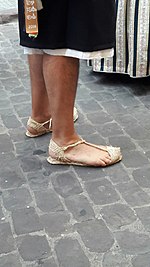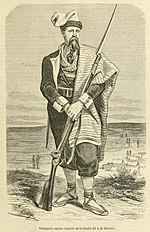Espadrille
This articleneeds additional citations forverification.(September 2014) |
| Type | Rope-soled shoe |
|---|---|
| Material | Canvasorcottonfabric upper andespartorope sole |
| Place of origin | Spain and France |
| Introduced | 1322 |
Espadrilles(Spanish:alpargatas or esparteñas;Catalan:espardenyes;Basque:espartinak,French:espadrilles)[1]are casual,rope-soled,flat but sometimeshigh-heeledshoes.They usually have acanvasorcottonfabricupper and a flexiblesolemade ofespartorope.The esparto rope sole is the defining characteristic of an espadrille; theuppersvary widely in style.
Espadrilles are a typical form of Spanish summer footwear, with strong historical ties to the regions ofCatalonia,Aragon,and theBasque Country.The word derives from theCatalan"espardenya" and refers toesparto grass,a plant indigenous to the south ofSpainthat is used to make ropes and basketry.[2]Although they are still widely manufactured in Spain, some production has moved toBangladesh,the world's largestjuteproducer.[3]
Originallypeasantfootwear,[4][5]they were popularised throughout the 20th century by many cultural figures includingPicasso,Salvador Dalíand laterJohn F. KennedyandYves Saint Laurent.[6]
Etymology
[edit]
The existence of this kind of shoe in Europe is documented since at least 1322, when it was described for the first time with its currentCatalanname.

The termespadrilleis French and derives from the word in theOccitan language,which comes fromespardenyainCatalanoralpargataandesparteñain Spanish. Bothespardenyaandesparteñarefer to a type of shoes made withesparto,a tough, wiry Mediterranean grass used in making rope.[7]Its name in the Basque region isespartina.[8]
History
[edit]
Espadrilles have been made in theBasque Country,Cataloniaand roughly all overSpainas well as theOccitaniaregion of France. They were the usual peasant footwear since the 14th century at least, and are still being produced as from old. The oldest, most primitive form of espadrilles dates as far back as 9,500 years ago.[9]Traditional espadrilles have acanvasupper with the toe and vamp cut in one piece and seamed to the rope sole at the sides. Often they have laces at the throat that are wrapped around the ankle to hold the shoes securely in place. Traditional espadrilles are worn by both men and women.
Use in Argentina and Uruguay
[edit]Both in Argentina and Uruguay, espadrilles (known as alpargatas) were adopted by rural workers as a substitute for the "bota de potro",part of the traditional gaucho attire, made with leather from the lower leg of the horse. Unlike other clothing, the espadrille became an essential garment for both sexes but, above all, the inseparable companion of thebombachas(knickerbockers). In the first half of the 20th century, the use of espadrilles was so common among the lower classes of the population that the company calledFábrica Argentina de Alpargatastook great importance, which used to be promoted with the artisticalmanacsillustrated byFlorencio Molina Campos.Espadrilles entered the Argentine political scene prior to the presidency ofJuan Domingo Perónby associating it with theworking class.In 1943 and 1944, the student movement opposed to Perón began to use the slogan: "No a la dictadura de las alpargatas" ( "No to espadrilles' dictatorship" ) which was in turn responded by theperonists:"alpargatas sí, libros, no" ( "espadrilles, yes, books, no" ).[10]
Modern espadrilles
[edit]Oncepeasantfootwear,then urban workers' footwear, espadrilles have grown in popularity, especially in the French Atlantic coast of the Basque Country and Spanish Mediterranean coast from Granada to Girona, where many men and women wear them during the spring and summer months. Designer espadrilles are now widely available. They are usually manufactured in Spain, France, and South Asia. Modern espadrilles are predominantly for women, though some men's shoes are made in this style.
The soles of espadrilles may be flat, platform, or wedge shaped made ofnatural fiber.Uppers may be made from nearly any substance and may have open or closed toes, open or closed backs, and can be slip-on or tied to the ankle with laces. Thousands of varieties of espadrilles can be found, from inexpensive bargain brands to high priced designer brands.
Espadrilles became fashionable in the United States in the 1940s.Lauren Bacall's character in the 1948 movieKey Largowore ankle-laced espadrilles.
Wedge-shaped espadrilles were first popularized by French fashion designerYves Saint Laurent.At a trade fair in Paris in 1970, he came into contact with the Spanish espadrille manufacturerCastañer.Yves Saint Laurent had been looking in vain for months for someone to make him a wedge espadrille. Castañer managed to interpret Yves Saint Laurent's vision and the wedge espadrilles were an instant hit, influencing fashion even today.
The espadrille style was revived in the United States in the 1980s, due to the success ofMiami Vice—the shoe was worn by the character Sonny Crockett (played byDon Johnson). In 2013 at luxury shoe stores in New York City, a pair of espadrilles could cost nearly $500.[11]
Jute sole espadrilles
[edit]Due to cost and material availability, the soles of espadrilles are now commonly made with jute rope or braid. The natural bright white color of jute is a major design feature of modern espadrilles.
Bangladeshis the producer of high quality jute and has become a manufacturing center for premium quality jute soles and complete espadrilles.[12]Ninety percent of the world's total production of complete espadrilles, as well as jute soles, is now manufactured in Bangladesh, although some manufacturers inSpain,France,andItalyimport jute soles from Bangladesh to finish espadrilles in those countries. Complete espadrilles are also assembled inArgentina,Bolivia,Chile,Colombia,ParaguayandVenezuelawith imported jute from Bangladesh.
Jute soles typically include fully or partiallyvulcanized(hardened) rubber beneath the jute soles for long-lasting espadrille shoes. Sometimescrepe rubbersoles are used asout-soles,although they are less durable than their vulcanized counterparts. Jute braid soles might include heels made of wood orEVA foam.
Manufacture
[edit]The manufacture of espadrilles is generally more complex than that of sandals. The jute soles are the most critical part. The jute twines are first machine-braided. These braids are then manually formed into the shape of the sole andhydraulicallypressed with heat to form the final shape and completed with vertical stitching with Espadrille Needles.[13]These basic soles are thenvulcanizedunderneath. EVA foam or woodenheelsare glued in place and more jute braids are wrapped around it to complete the soles. Uppers of different styles are then built on the jute soles to complete the espadrille.
See also
[edit]- Bast shoes,similar footwear in Balto-Slavic cultures of identical etymological derivation (from fibre used in their manufacture)
- Waraji,Japanese version
References
[edit]- ^Josep Escrig I Martínez,Diccionario Valenciano-Castellano,Imprenta de J. Ferrer de Orga (Valencia, 1851), p. 385
- ^Barrie Kerper,Barcelona from A to Z,Vintage (Mar., 2017)
- ^Margo DeMello,Feet and Footwear: A Cultural Encyclopedia,Greenwood Press (2009), p. 108
- ^Sanjay Kathuria et al.,Toward New Sources of Competitiveness in Bangladesh: Key Insights of the Diagnostic Trade Integration Study,World Bank Publications (oct., 2015), p. 86
- ^Chris Cotonou, "Spanish Menswear Brands Deserve Your Attention—and Your Closet Space" inRobbReport,July 27, 2020
- ^Emily Lever, "The Revolutionary History of Espadrilles" inEsquire(17 August 2017)
- ^"What are Espadrilles?".wiseGEEK.Retrieved30 April2016.
- ^Espartinain the official website of the community of Soule municipalitiesArchived2014-07-07 at theWayback Machine
- ^"The earliest basketry in southern Europe: Hunter-gatherer and farmer plant-based technology in Cueva de los Murciélagos".
{{cite journal}}:Cite journal requires|journal=(help) - ^López, Alfredo (1975)Historia del movimiento social y la clase obrera argentina,p. 410 (spanish).
- ^"Shoe Battles: Going Toe-to-Toe in Stilettos".Retrieved30 April2016.
- ^"Espadrille".Retrieved30 April2016.
- ^Dritz ES50063


